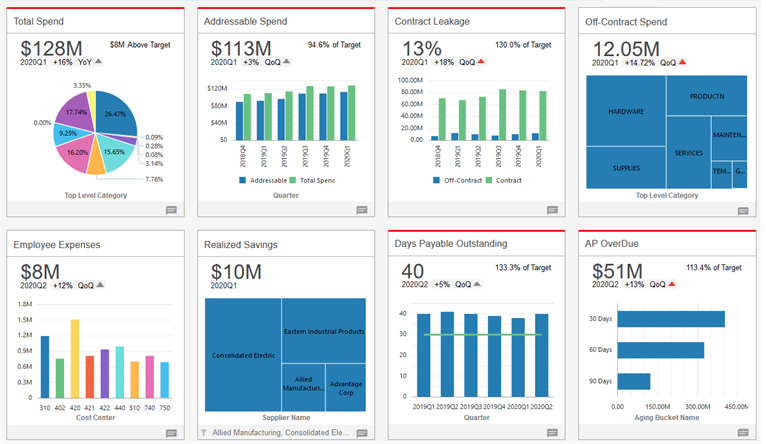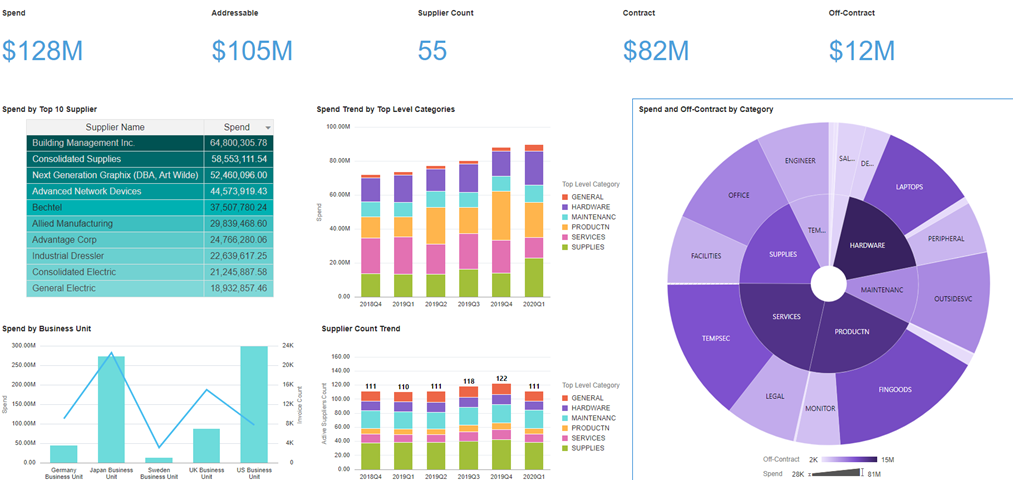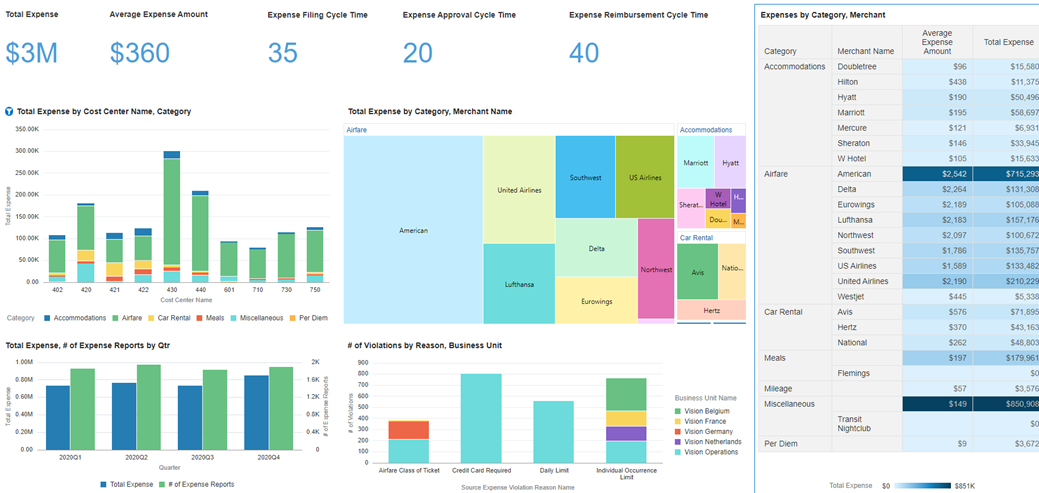The phrase “supply chain resilience” blossomed into widespread public consciousness amidst the global pandemic. As a society, we’ve dealt with rapid fluctuations in supply for items like toilet paper, hand sanitizer, the N-95 mask, and of course, the vaccine.
For those who work in Operations, however, the quest for greater organizational agility has always been critical and has relied heavily on cost optimization. To stay afloat, many businesses have had to dig deep to maximize cash on hand and re-route budget to meet critical needs.
Learn more about Spend Analytics: Spend Analysis Product Tour
Recent Deloitte survey findings concluded that two-thirds of organizations globally are planning to pursue cost reduction strategies post-COVID-19, as compared to one-third pre-pandemic.
McKinsey’s 2021 “Memo to the CFO” similarly reminds us that, despite the pandemic’s divergent impact on various sectors of the economy, all businesses have come to terms with “…the need for greater speed and cost control amid ongoing, unprecedented uncertainty.”
Enter spend analysis, which has become a fundamental tool in the arsenal of organizations seeking to balance cost management with flexibility. Spend analysis provides a deeper look into organizational expenditures, allowing us to identify patterns of excess, seek lower costs for goods and services, or shift resources to areas of the business where they are needed most.
However, the enhanced visibility afforded by spend analysis can come at a high cost. Pertinent organizational data is frequently housed within multiple distinct (often incompatible) supply chain and ERP systems. Insight extraction can become a technological nightmare that further strains resources.
For those charged with the data wrangling needed to conduct spend analysis, weaving together disparate data sources across Finance and Procurement is complex, time-consuming, and can be error-prone. This makes it a herculean task to monitor the comprehensive impact of procurement and employee expenses on financial metrics.
What is Spend Analysis?
For those unfamiliar with spend analysis, here’s a brief primer:
Spend analysis, when performed well, is an invaluable tool for finance and procurement departments. Deeper visibility into an entire company’s spend patterns affords business leaders greater control over margins, be it by gaining operational efficiencies, negotiating better pricing terms, or minimizing risk throughout the procure-to-pay journey.
Deloitte’s 2020 Flash Survey of CPOs indicates that cost management is the top priority for procurement executives right now, commanding roughly “8 times more day-to-day focus than other areas.”
By empowering organizations to identify actionable opportunities for cost savings, spend analysis promotes business agility and resilience. Spend analysis is a critical tool within the Procurement organization and serves as the basis of strategic sourcing.
“Spend analytics will have a critical role not only in helping leaders monitor and improve cash and cost but also in transforming and improving existing practices to create a more resilient future.” – – McKinsey, “The Role of Spend Analytics in the Next Normal”
Now more than ever, company-wide analysis into resource allocation has proven essential, enabling businesses to succeed amidst global uncertainty. Spend analysis helps organizations navigate unpredictable markets by answering questions like:
- Are we negotiating the most competitive pricing terms possible?
- Do my top spend categories mirror organizational objectives?
- Who are my top suppliers by region, and how have they changed over time?
- Where have we unnecessarily foregone price discounts, incurred late fees, or damaged supplier relationships?
Spend Analysis Challenges
It’s difficult to reap the rewards of these benefits when visibility into spend patterns is neither quick nor easy. Resultantly, those overseeing spend — Procurement Officers, Category Managers, Buyers — don’t always receive access to key spend insights in a timely manner, nor on a regular basis. The type of in-depth analysis needed to effectively reduce costs may require custom reports, meaning that spend insights are seen monthly or quarterly, when weekly (or even daily) updates would promote business agility.
Moreover, it can be challenging to spot nuanced trends quickly. Finance and Procurement generate mountains of data, and without the proper analytics tools, organizations can be slow to surface the root cause of non-compliance, patterns of excess, or inefficient processes that prevent optimal performance. It is often difficult to spot granular trends across large volumes of data unless the user knows what pattern they are looking for in advance.
Introducing Oracle’s New Spend Analysis Capability
Oracle has launched its newest spend analysis capability for Oracle Fusion ERP Analytics to address issues specifically related to cost management. The product seamlessly bridges finance and procurement data to provide in-depth cost optimization insights to CPO and CFO organizations.
The value of this new subject area for Oracle Fusion ERP Analytics lies in the actionable insights it provides across myriad dimensions, such as category, business unit, geography, etc. It allows users to easily compare organizational spend performance against budgetary benchmarks, while proactively monitoring compliance.
Increased Clarity to Optimize Costs with Oracle Analytics
Strategic key performance indicators (KPI’s) come pre-populated with your organization’s data, enabling instant visibility into patterns across procurement spend, and employee expenses:
Spend Analysis
- Total Spend
- Addressable Spend
- PO and Non-PO Spend
- Agreement-based Spend
- Agreement Leakage
- Negotiated Spend
- Employee Expenses (AP)
- Max, Min, Average Unit price
Employee Expenses
- Employee Expenses (T&E)
- Credit Card
- Cash
- Personal
- Audit Adjustments

Complicated spreadsheet configuration will no longer haunt you in your sleep. Swiftly unearth “rogue” or “maverick” spend patterns to consolidate purchasing categories and negotiate the most competitive pricing rates with suppliers.
Manage risk by uncovering the nuanced trends across your organizational expenditure data: machine learning proactively surfaces the root cause of non-compliance, patterns of fraud, and internal process bottlenecks.
With one glance, answer questions such as:
- How does my spend differ by business unit, category, and geography over time?
- How has contract leakage affected my bottom line?
- Which categories have realized the greatest amount of savings?
- How has my addressable spend to total spend ratio performed over time, and what has caused anomalies?
- Where can I transform off-contract spend into managed spend? How can I reduce expense approval cycle times?

Monitor your organization’s procurement performance to verify that you are accurately allocating cash and human capital. Gain accurate insight into staffing needs across the procure-to-pay process. Streamline employee expense policies & audit processes to speed reimbursement. Determine how your organization can improve its cash position by strategically extending payables with certain suppliers.

This offering not only leverages ML and AI to proactively uncover hidden cost savings; it furthers an organization’s bottom line by eliminating the strenuous ETL process and its cumbersome maintenance. With the time saved and peace of mind restored, both business users and IT can focus on strategic initiatives rather than tedious data configuration.
Navigate Disruption with Oracle Fusion ERP Analytics
Multidimensional visibility into company-wide spend patterns expedites the ability to widen margins. Spend analysis affords businesses the dexterity to succeed amidst disruption, by providing the foresight needed to mitigate risk and promote profitability– whether by diversifying supplier geographies and nearshoring production facilities or by adjusting manufacturing processes to meet demand.
Oracle’s initial offering of Spend Analysis for Fusion ERP Analytics lays the foundation for upcoming procurement analytics capabilities and sets the stage for our robust future Supply Chain Analytics product. It extends the value of Fusion ERP Analytics and Oracle Procurement Cloud by enabling organizations to meticulously reduce their expenditures throughout the procure-to-pay process.
To learn more, visit Oracle.com/analytics, and follow us on Twitter@OracleAnalytics.
